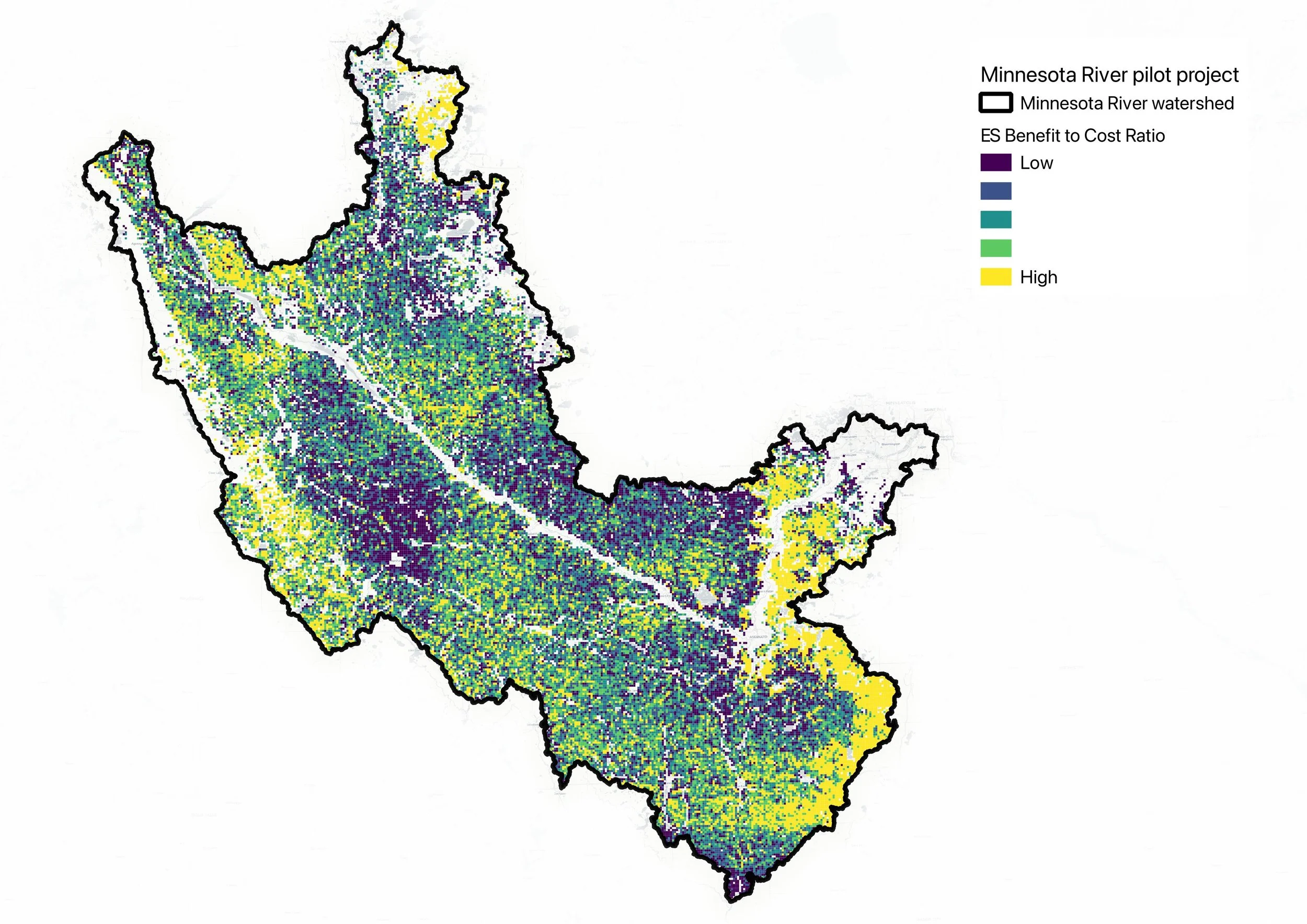Mapping Benefits of Natural Climate Solutions
Project Overview
Project Drawdown tasked us with creating a ‘roadmap’ to reveal top-priority locations for natural climate solutions for agriculture across the continental United States. Natural climate solutions are actions to protect, better manage and restore nature to reduce greenhouse gas emissions and store carbon. At the same time, these actions provide other benefits to people in the form of water quality protection, nature access, and many other examples.
But deciding where to implement these solutions to maximize benefits to people and nature can be complex: what actions will produce the most benefit, and to whom? Where are the best sites for which actions? How do we choose sites that provide the most benefits across multiple services? Many actors wishing to explore natural climate solutions struggle with these questions, from city leaders developing zoning plans to resource managers and conservation leaders developing large-scale restoration efforts. What was needed was a path forward based on sound understanding of nature’s potential benefits.
To address this knowledge gap, we developed a roadmap that reveals where a selection of natural climate solutions can have the greatest impact on five key ecosystem services: sediment erosion prevention, nitrogen runoff prevention, phosphorus runoff prevention, pollinator habitat quality, and carbon sequestration.
Ecosystem service benefit-to-cost ratio for one watershed in the Midwest US, using combined benefits of all ecosystem services modeled and estimated restoration acquisition costs | © NatCap Insights
What We Did to Help
-
We chose four climate solutions that have significant potential to improve ecosystem services: cover crops, fertilizer reduction, riparian buffers, and habitat restoration.
-
We divided all agricultural land in the United States into uniformly shaped 64-hectare square parcels, which acted as the individual ‘farms’ where climate solutions’ potential could be measured. We evaluated over 2.1 million such farms across the country.
-
We modeled ecosystem services using the InVEST toolkit—Pollination, Sediment Delivery Ratio (SDR), Nutrient Delivery Ratio (NDR)—and one model (Carbon) adapted from a recent World Bank study.
-
We assessed the potential for each farm to improve its ecosystem services with the application of natural climate solutions.
-
We produced a case study on prioritizing grassland restoration for the Minnesota River Watershed on a fixed budget, demonstrating how selecting areas based on their benefit:cost ratio can greatly improve outcomes.
What We Created
Nationwide maps showing where agricultural lands are currently providing the greatest benefit to people in terms of nutrient runoff prevention, pollinator habitat quality, erosion prevention, and carbon sequestration.
Nationwide maps of which parcels perform best for each service under each climate solution. As an example, the map below shows where habitat restoration would be most effective at reducing harmful nitrogen pollution into rivers and streams. Similar maps were created for each of the natural climate solutions and their potential benefits.
Portfolio analysis of natural climate solutions for one case study area: habitat restoration in the Minnesota River Watershed. We created four land acquisition portfolios for restoration using different selection criteria: (1) selecting the most efficient ecosystem service benefit-to-cost ratios first, (2) selecting the cheapest land first, (3) random choice, and as a worst-case reference (4) selecting the least efficient ecosystem service benefit-to-cost ratios first.
This map shows selected farm blocks for the ‘most efficient’ and ‘cheapest’ restoration portfolio selection strategies, for one case study in the Midwest US | © NatCap Insights
Impact
With precise knowledge of ecosystem service potential, any decision-maker tasked with improving the environmental benefits of a landscape can do more with a tighter budget. Our analysis showed that choosing restoration sites efficiently more than doubled the benefits of choosing randomly. In our deep dive analysis, the cheapest restoration portfolio tended to cluster investments in areas with the lowest land acquisition cost but with a lower overall benefit:cost ratio (median BC = 0.94), while the most efficient portfolio suggests more widespread but also more effective interventions (median BC = 1.44).
Cumulative ecosystem service benefit as a function of cost for different restoration portfolio selection strategies.
This study produced a national-scale assessment of the most cost-effective places to invest in natural climate solutions in US agricultural landscapes. These actions combat climate change while simultaneously providing benefits to local communities and food producers by reducing erosion, supporting native pollinators, and reducing the negative impacts of nutrient pollution in waterways.





